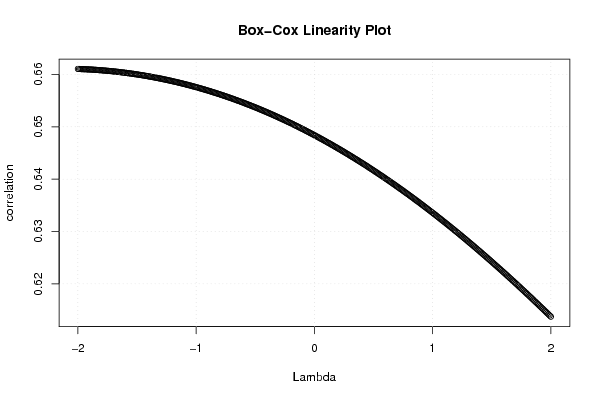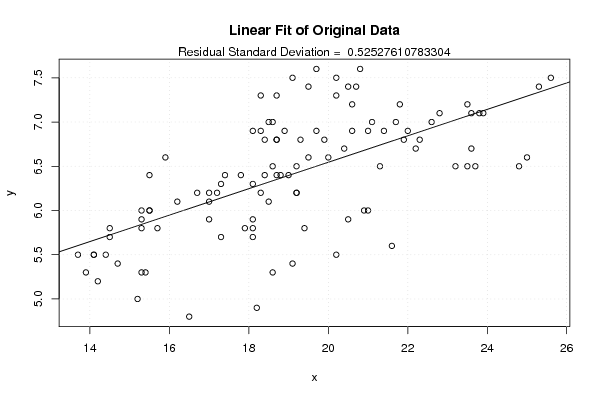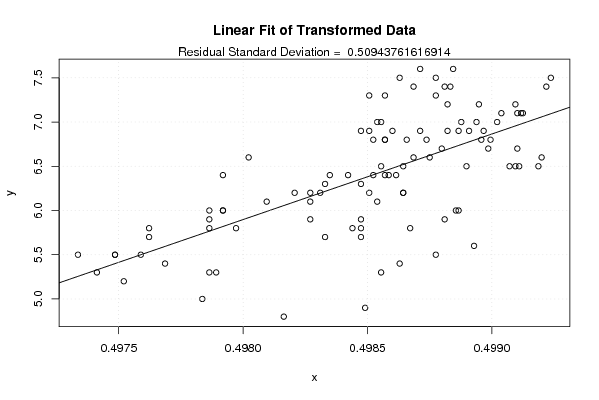Free Statistics
of Irreproducible Research!
Description of Statistical Computation | |||||||||||||||||||||||||||||||||||||||||||||
|---|---|---|---|---|---|---|---|---|---|---|---|---|---|---|---|---|---|---|---|---|---|---|---|---|---|---|---|---|---|---|---|---|---|---|---|---|---|---|---|---|---|---|---|---|---|
| Author's title | |||||||||||||||||||||||||||||||||||||||||||||
| Author | *The author of this computation has been verified* | ||||||||||||||||||||||||||||||||||||||||||||
| R Software Module | rwasp_boxcoxlin.wasp | ||||||||||||||||||||||||||||||||||||||||||||
| Title produced by software | Box-Cox Linearity Plot | ||||||||||||||||||||||||||||||||||||||||||||
| Date of computation | Wed, 12 Nov 2008 05:14:45 -0700 | ||||||||||||||||||||||||||||||||||||||||||||
| Cite this page as follows | Statistical Computations at FreeStatistics.org, Office for Research Development and Education, URL https://freestatistics.org/blog/index.php?v=date/2008/Nov/12/t1226492997wvv9gggwxgiy4om.htm/, Retrieved Sun, 19 May 2024 06:27:34 +0000 | ||||||||||||||||||||||||||||||||||||||||||||
| Statistical Computations at FreeStatistics.org, Office for Research Development and Education, URL https://freestatistics.org/blog/index.php?pk=24153, Retrieved Sun, 19 May 2024 06:27:34 +0000 | |||||||||||||||||||||||||||||||||||||||||||||
| QR Codes: | |||||||||||||||||||||||||||||||||||||||||||||
|
| |||||||||||||||||||||||||||||||||||||||||||||
| Original text written by user: | |||||||||||||||||||||||||||||||||||||||||||||
| IsPrivate? | No (this computation is public) | ||||||||||||||||||||||||||||||||||||||||||||
| User-defined keywords | |||||||||||||||||||||||||||||||||||||||||||||
| Estimated Impact | 157 | ||||||||||||||||||||||||||||||||||||||||||||
Tree of Dependent Computations | |||||||||||||||||||||||||||||||||||||||||||||
| Family? (F = Feedback message, R = changed R code, M = changed R Module, P = changed Parameters, D = changed Data) | |||||||||||||||||||||||||||||||||||||||||||||
| F [Box-Cox Linearity Plot] [box-cox linearity...] [2008-11-12 12:14:45] [a16dfd7e948381d8b6391003c5d09447] [Current] | |||||||||||||||||||||||||||||||||||||||||||||
| Feedback Forum | |||||||||||||||||||||||||||||||||||||||||||||
Post a new message | |||||||||||||||||||||||||||||||||||||||||||||
Dataset | |||||||||||||||||||||||||||||||||||||||||||||
| Dataseries X: | |||||||||||||||||||||||||||||||||||||||||||||
15,9 15,5 15,3 14,5 14,4 14,7 19,1 21,6 20,2 17,9 15,7 14,5 14,1 13,9 14,2 15,3 15,4 15,2 16,5 18,2 18,6 21 19,2 18,7 18,4 17,8 17,2 16,2 15,5 15,3 18,3 19,2 19 18,7 18,1 18,5 21,1 21 20,4 19,5 18,6 18,8 23,7 24,8 25 23,6 22,3 21,8 20,8 19,7 18,3 17,4 17 18,1 23,9 25,6 25,3 23,6 21,9 21,4 20,6 20,5 20,2 20,6 19,7 19,3 22,8 23,5 23,8 22,6 22 21,7 20,7 20,2 19,1 19,5 18,7 18,6 22,2 23,2 23,5 21,3 20 18,7 18,9 18,3 18,4 19,9 19,2 18,5 20,9 20,5 19,4 18,1 17 17 17,3 16,7 15,5 15,3 13,7 14,1 17,3 18,1 18,1 | |||||||||||||||||||||||||||||||||||||||||||||
| Dataseries Y: | |||||||||||||||||||||||||||||||||||||||||||||
6,6 6,4 6 5,8 5,5 5,4 5,4 5,6 5,5 5,8 5,8 5,7 5,5 5,3 5,2 5,3 5,3 5 4,8 4,9 5,3 6 6,2 6,4 6,4 6,4 6,2 6,1 6 5,9 6,2 6,2 6,4 6,8 6,9 7 7 6,9 6,7 6,6 6,5 6,4 6,5 6,5 6,6 6,7 6,8 7,2 7,6 7,6 7,3 6,4 6,1 6,3 7,1 7,5 7,4 7,1 6,8 6,9 7,2 7,4 7,3 6,9 6,9 6,8 7,1 7,2 7,1 7 6,9 7 7,4 7,5 7,5 7,4 7,3 7 6,7 6,5 6,5 6,5 6,6 6,8 6,9 6,9 6,8 6,8 6,5 6,1 6 5,9 5,8 5,9 5,9 6,2 6,3 6,2 6 5,8 5,5 5,5 5,7 5,8 5,7 | |||||||||||||||||||||||||||||||||||||||||||||
Tables (Output of Computation) | |||||||||||||||||||||||||||||||||||||||||||||
| |||||||||||||||||||||||||||||||||||||||||||||
Figures (Output of Computation) | |||||||||||||||||||||||||||||||||||||||||||||
Input Parameters & R Code | |||||||||||||||||||||||||||||||||||||||||||||
| Parameters (Session): | |||||||||||||||||||||||||||||||||||||||||||||
| Parameters (R input): | |||||||||||||||||||||||||||||||||||||||||||||
| R code (references can be found in the software module): | |||||||||||||||||||||||||||||||||||||||||||||
n <- length(x) | |||||||||||||||||||||||||||||||||||||||||||||

















